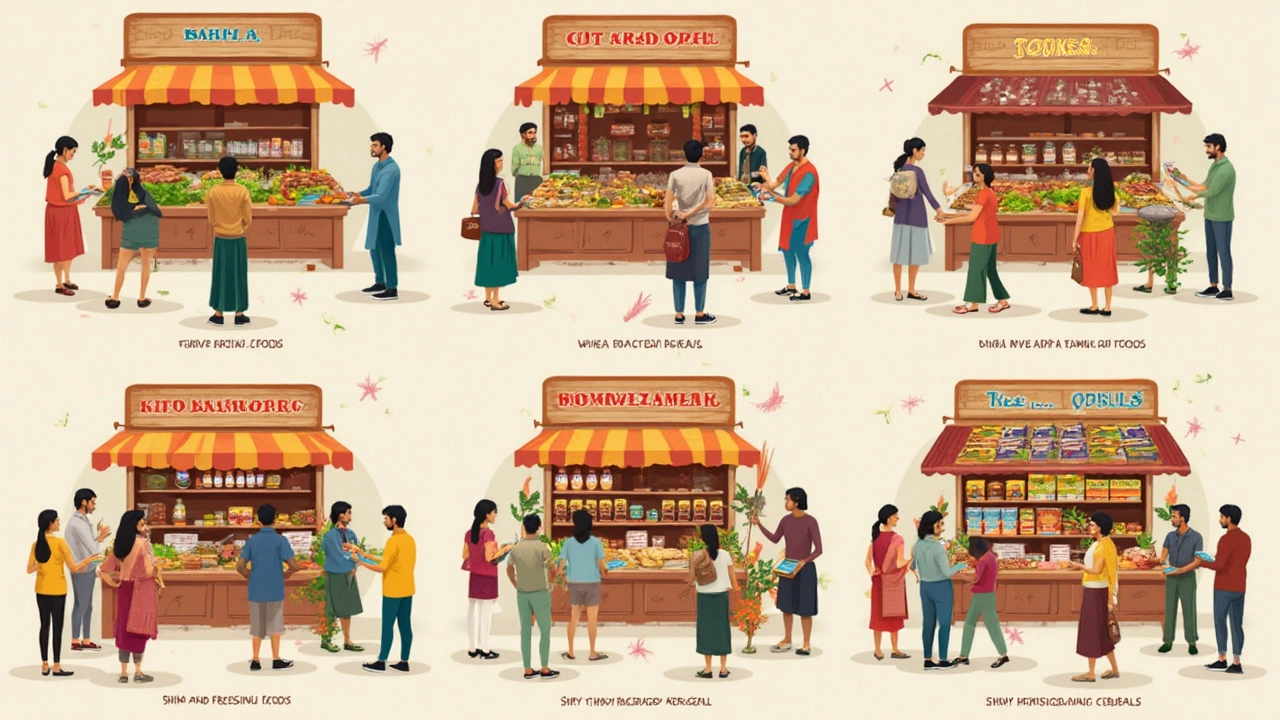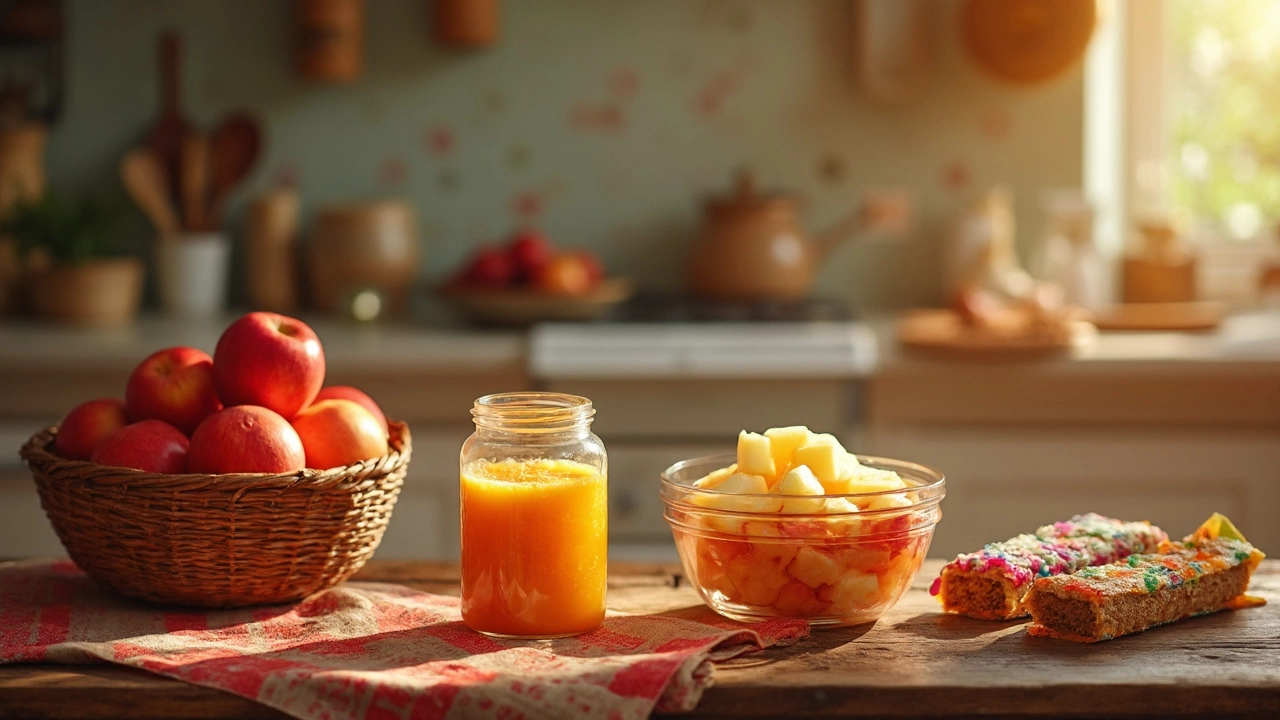Ever wondered what goes on between the farm and your fork? Food isn’t just fresh or junk—there’s a whole spectrum of processing that shapes what we eventually eat.
Understanding the four levels of food processing isn’t just for nutrition geeks or factory workers. It can actually change the way you shop at the grocery store or cook dinner. Knowing what separates an apple from applesauce, or homemade bread from a snack cake packed in plastic, helps you spot healthier choices without getting stuck reading every single label in the aisle.
Here's something interesting: some foods are barely touched between the field and your kitchen, while others go through a whole science experiment before they hit your plate. Each type of processing comes with its own quirks and pros and cons. Picking up on these differences will help you make better calls about what to eat, especially if you're watching out for additives or just trying to eat more whole foods.
- Unprocessed and Minimally Processed Foods
- Processed Culinary Ingredients
- Processed Foods
- Ultra-Processed Foods
Unprocessed and Minimally Processed Foods
If you bite into a banana, drink a glass of milk, or eat a handful of raw almonds, you’re enjoying what experts call unprocessed or minimally processed foods. These foods are as close as it gets to their original state, usually just cleaned, chopped, frozen, or packaged for convenience. No extra stuff is added, and there’s barely any change to how they taste or what nutrients they’ve got.
Think of foods like:
- Fresh fruits and vegetables
- Raw or roasted nuts (no added salt or sugar)
- Milk and plain yogurt
- Eggs, meats, and fish without flavorings or preservatives
- Dry grains like rice or oats
This first level of food processing is all about making sure food is safe and easy to eat. A carrot washed and cut into sticks is still just carrot. An apple in a bag is still an apple. The point isn’t to strip away vitamins or add chemicals—it’s to get safe, edible stuff from the farm to your kitchen with the least fuss possible.
You might be surprised how much of the supermarket is actually filled with these basic options. According to a 2023 survey, about 30% of an average grocery store’s produce section is made up of unprocessed or minimally processed foods.
| Food Item | Level of Processing |
|---|---|
| Raw spinach | Unprocessed |
| Frozen peas | Minimally processed |
| Bottled water | Unprocessed |
| Rolled oats | Minimally processed |
Here’s a quick tip: if the stuff you’re eating could pass for something your grandparents would recognize, you’re probably looking at the lowest level of processing. If you want to up your nutrition, fill half your plate with foods that come from this category at every meal.
Processed Culinary Ingredients
Here’s where things start to get interesting. Processed culinary ingredients aren’t foods you’d eat by themselves for dinner, but you use them in your kitchen all the time. Think sugar, flour, oils, salt, and butter. These are made by taking an unprocessed food—like sugarcane, wheat, or olives—and extracting or refining key parts. The point is, these ingredients get a little mechanical or chemical help, but they’re still pretty close to their natural state.
For example, you wouldn’t eat a spoonful of plain flour, but you might combine it with eggs and milk to make pancakes. Or take vegetable oil—made by pressing or processing seeds like soybeans or canola—to fry up some potatoes. These ingredients help you turn whole foods into all kinds of home-cooked meals.
Let’s break down some common processed culinary ingredients and how they’re made:
- Oils: Pressed or refined from seeds, nuts, or fruits (like olive oil, sunflower oil).
- Sugar: Extracted and crystallized from sugarcane or sugar beets.
- Salt: Mined from the earth or evaporated from seawater.
- Flour: Milled from whole grains like wheat or rice.
A quick look at the numbers shows you just how much we rely on these basics. Here’s a table with some average annual usage stats for a typical family of four in the US:
| Ingredient | Annual Use (kg) |
|---|---|
| Sugar | 43 |
| Flour | 60 |
| Vegetable Oil | 34 |
| Salt | 8 |
These numbers aren’t random—they come from USDA surveys. The catch is, while using these ingredients is normal, the real issue starts when they turn up in huge amounts in processed foods. On their own, though, these ingredients are what most home cooks use every day. If you’re looking to eat better, try watching how often you add sugar or oil to your meals—sometimes a small swap can make a big difference in how balanced your food ends up.
So next time you’re cooking, remember: processed culinary ingredients are a bridge between whole foods and more complex recipes. Use them with purpose, and you’re halfway to healthier eating without giving up flavor or fun in the kitchen.

Processed Foods
When you hear "processed foods," it's easy to think of stuff packed with sugar and weird chemicals. But actually, this category isn’t the worst level—processed foods are often made by adding salt, sugar, oil, or extra ingredients to real foods to help with shelf life, flavor, and convenience. Classic examples? Think canned beans, cheese, fresh bread, or jarred pickles.
The key thing here is that processed foods usually contain only a few extra things and you can still recognize the original ingredient. You’ll often see these foods in your fridge or pantry. They save time—like grabbing a loaf of whole-grain bread or a can of tomato soup when you don’t feel like cooking from scratch.
Here's a quick look at the most common types:
- Cheese made from milk, salt, and rennet
- Canned vegetables with a bit of salt added
- Bottled sauces that don’t use tons of additives
- Freshly baked bread (the kind with just flour, yeast, salt, and water)
- Cold cuts or smoked fish (just watch the sodium content)
Food processing at this level is all about boosting taste, shelf life, or making foods easier to eat without completely changing the food. For comparison, here’s a simple breakdown:
| Product | What’s Added | Main Purpose |
|---|---|---|
| Canned Tuna | Salt, oil or water | Preservation |
| Cheese | Salt, enzymes | Flavor & texture |
| Bread | Yeast, salt | Texture & shelf life |
Watch out though: processed doesn’t always mean healthy. Some products, like store-bought soups or certain cheeses, can have a lot of salt. Always glance at the label to keep an eye on sodium or sugar—just because something’s not ultra-processed doesn’t mean it’s perfect for you.
Ultra-Processed Foods
If you walk into any supermarket today, it’s almost impossible to miss the sea of ultra-processed foods. We’re talking about products like packaged chips, soft drinks, candy bars, instant noodles, sugary breakfast cereals, and even some plant-based meat alternatives. What sets these foods apart is how much they’re changed from their original state and how many ingredients you wouldn’t find in your own kitchen—think preservatives, colorings, fake flavors, and texturizers.
Most ultra-processed foods are made in factories with ingredients that sound more at home in a lab than on your plate. Instead of simple kitchen staples, you’ll see stuff like high-fructose corn syrup, hydrogenated oils, soy protein isolate, artificial sweeteners, and flavor enhancers. Why do companies do this? These ingredients make food taste better, last longer on the shelf, and look more appealing—but often at the expense of real nutrition.
The problem is, eating lots of ultra-processed foods is linked to higher risks of obesity, heart disease, diabetes, and even some cancers. Studies, like the one published in the “British Medical Journal” in 2023, show people who consume more of these foods tend to have more health problems compared to those sticking with less processed items.
- Ultra-processed foods are often loaded with sugar, salt, and unhealthy fats.
- They usually contain additives your body doesn’t actually need, like artificial colors and stabilizers.
- Food companies engineer textures and flavors to make these products hard to stop eating—hello, snack addiction.
Spotting ultra-processed foods is usually simple if you scan the label. If you see a long list of ingredients—many of which sound nothing like real food—or if the product comes in bright, flashy packaging, chances are you’re looking at the most processed level there is. If eating healthier is your goal, cutting back on these is probably the single best thing you can do. Remember, just because something is marketed as “natural” or “healthy,” doesn’t mean it skips the heavy processing. This stage stands out in the food processing world for being the furthest from the farm and the trickiest for your health.
